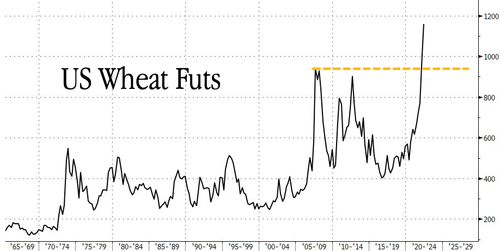Wheat Farmland Under Threat Worldwide As USDA Reveals Dismal Grain Outlook
Across the world, top wheat-producing regions are experiencing adverse weather conditions that could threaten production. In places like Ukraine, a military invasion by Russia has slashed production significantly. All of this suggests the world is on the cusp of a food crisis.
Droughts, floods, and heatwaves have plagued farmland in the U.S., Europe, India, and China. As for Ukraine, the world's largest wheat producer, the war could slash production by upwards of a third. There's one exception: Russia, which is expected to have a bumper crop as wheat prices soar.
"If there was ever a year where we needed to see optimum conditions and strong yields around the world, this was going to be it.
"Clearly that situation is not being seen. It adds more risk to this highly volatile situation," said James Bolesworth, managing director at CRM AgriCommodities, told Bloomberg.
Bloomberg provides a current snapshot of what's happening globally in wheat markets.
European Union
Warm, dry weather is a burgeoning concern in the world's top wheat exporter, after a favorable start to spring. Crops in half the wheat belt lack rain at the onset of a key development period, and temperatures in top grower France have soared to summer-like levels unseasonably early. While the production outlook could still brighten, much will hinge on whether the water deficit eases in the next few weeks.
"If the lack of rain persists until the end of the month, we'll have to look again at our yield forecasts," said Aurelien Blary, a crop analyst at Strategie Grains.
United States
Dryness plaguing the U.S. Central Plains has already led some growers to write off parched hard red winter wheat, used by millers and bakers for bread flour. Harvests in top producer Kansas start next month, and output will fall "well below" the five-year average, said Aaron Harries, vice president of research and operations for Kansas Wheat. Crop insurance agents expect some fields to yield zero to five bushels an acre, versus the normal 35 to 40 bushels, he said.
The supply pinch threatens to send elevated grain prices even higher, worsening inflation across supply chains and hurting U.S. exports. "Everything west of the Mississippi River needs rain," Harries said. "If we don't have those regular showers, the size of the crop will get smaller every day."
Meanwhile, excessive rains further north are making it tough to plant spring wheat used to make bagels and pizza. Minnesota farmer Tim Dufault estimates his state has already lost about 5 bushels per acre in yield potential from the delays. Sowing in North Dakota has been "painfully slow," with only 8% seeded versus nearly two-thirds at this time last year, according to the state's wheat commission.
Canada
Similar dueling weather problems are playing out across the border. Cool temperatures delayed seeding in Canada, and producers are now trying to plant in fields that are either too wet or too dry.
Drought is a concern in southern Alberta, a growing area for spring wheat and durum used in pasta. Moisture there is lower than a year ago and dry, windy conditions are eroding soils, according to its agriculture ministry. Further east in Manitoba, a series of storms have sidelined farmers. More rain is in the forecast this week, casting doubt on progress anytime soon.
"Virtually 99% of the farmers haven't got to the field yet," said Bill Campbell, president of Keystone Agricultural Producers, noting it may take a week for things to dry once the rain stops. "It's back to square one."
India
Blistering heat scorched wheat fields in the world's second-biggest grower, damping expectations for exports to alleviate a global shortage. March temperatures soared to the highest ever for the month in records going back to 1901, parching the crop during a crucial period. That spurred estimates that yields will slump 10% to 50% this season.
The food ministry cut its production forecast to 105 million tons, from an earlier outlook of 111 million tons, and some traders think the crop will be even smaller. Severe heatwaves are continuing in parts of northern India, which may cause some harvest delays if people avoid going out.
China
China leads global wheat production, and there are concerns about its winter wheat after unusual autumn floods. Videos on social media show acres being cut down before maturation by farmers hoping to get a better price selling it for animal feed.
Fields are due to be harvested in about 20 days, and officials are investigating whether there has been any illegal destruction. China will want to limit its dependence on foreign supply after becoming one of the top importers over the past two seasons.
Black Sea
Soil moisture is satisfactory in Ukraine, buoying yield prospects. But the war will curb production, and there's worries about where to store the crop as backlogged exports leave silos bulging with last year's grain.
Russia has also seen favorable weather and could reap a near-record harvest. That's bolstered shipment prospects, although freight and insurance costs are high and some merchants are shunning its commodities.
On Thursday, wheat prices in Chicago rose 3.5% following the release of one of the most important World Agricultural Supply and Demand Estimates (WASDE) reports published by the USDA this year.
WASDE showed wheat production in Ukraine is expected to plunge by one-third this season compared with last year. The report also noted global corn production would decline while rice production could hit a record.
AGRICULTURAL MARKETS: The USDA just published its first really detailed look at 2022-23 crop year, painting a tight outlook for corn and wheat, with production down. On the other hand, rice will enjoy a larger -- and record high -- harvest | #OATT #Ukraine pic.twitter.com/MJgXcZRje4
— Javier Blas (@JavierBlas) May 12, 2022
Meanwhile, President Joe Biden on Wednesday outlined efforts to increase plantings to offset expected declines in global grain production.
https://ift.tt/U0nkKmd
from ZeroHedge News https://ift.tt/U0nkKmd
via IFTTT





0 comments
Post a Comment